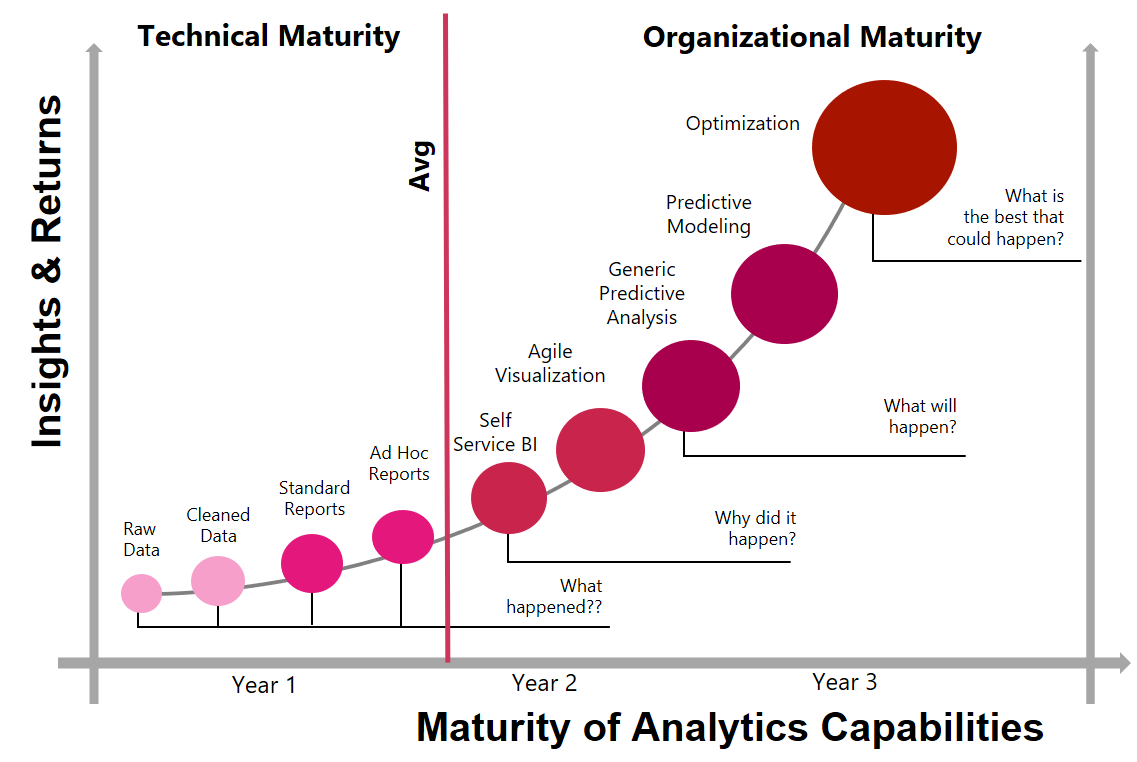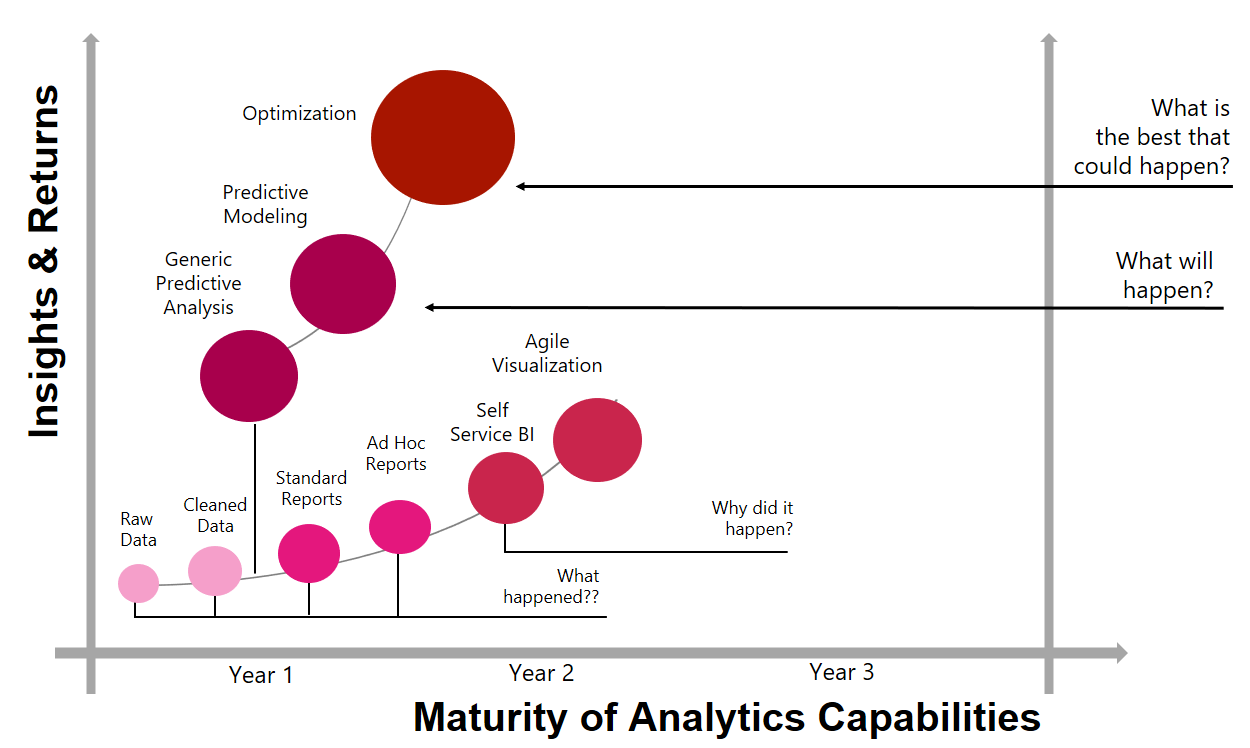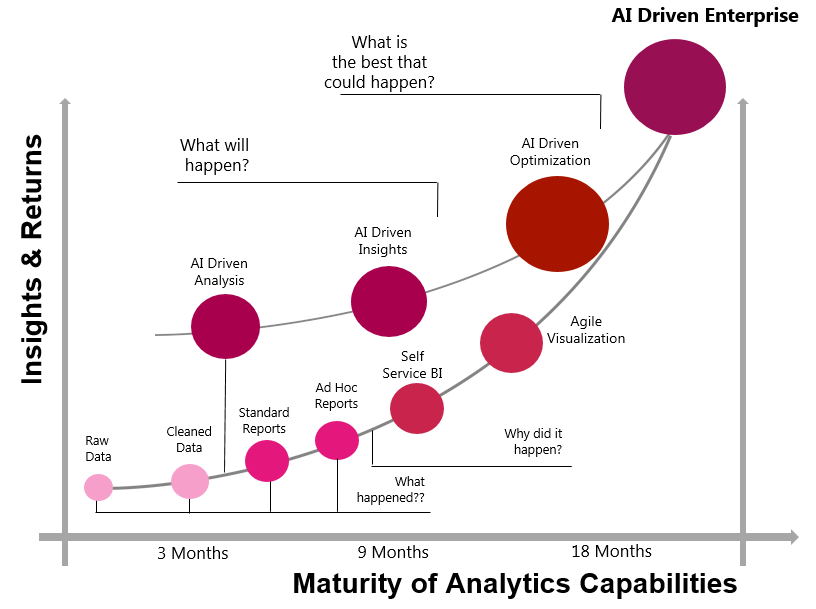AI-driven enterprises are widely expected to outperform their competition going forward. As an analytics consultancy, helping our clients become AI-driven and remain competitive is one of our core values. AI-derived business value is forecasted to reach $3.9 trillion in 2020, and we want our clients to capture it!
Historically, we visualized our clients’ initiatives to optimize their data usage as progressing linearly from data management to machine learning. Everyone has seen versions of the below visual – it is a traditional and comfortable way to plan initiatives, where machine learning (Predictive Modeling and Optimization) is left for the distant future:

Last year, we noticed that even our newer, less analytically mature clients were harboring ever-stronger drives to better utilize their data assets. On one side, they wanted self-service business intelligence (BI) that could enable everyone in the business to use data for decision making. Their C-levels, in addition, wanted a specific focus on solving strategic, big-picture problems that would make immediate impacts on their business and financials.
These strategic, top-down initiatives move our clients ahead of their competition. However, we see no reason not to run the bottom-up, self-service BI initiatives in parallel to these more specific needle-moving initiatives. As a result, the analytics maturity graphic that we show to our clients now looks a bit different:

The first step is always helping our clients to clean and consolidate data into some sort of centralized data platform. This piece often requires the most work, and sometimes the most investment, but it rarely requires a different approach than we use with our other clients. Fifty percent of data warehousing projects fail, but we believe these failures are often caused by the lack of an experienced team – people who haven’t completed dozens of similar projects. Once we’ve created an analytic platform of clean and consolidated data, the door is open for our parallel BI and machine learning approach.
To consider how this looks in practice, let’s consider a consumer goods company. Their business goals might look like this:
– Can I arm my sales reps with account-specific dashboards on their mobile devices to help them push more product into each account?
– Can I arm my sales managers with live budget vs forecast vs actuals dashboards that flag sales gaps by account or by sales rep?
– Can I get a complete and live view of my marketing spend across all platforms in one place to make faster adjustments to my campaigns?
– Can I predict and influence customer satisfaction with my products?
– What product will sell the best in a new market?
– Which of my products are consumers buying together?
– How can my supply chain become leaner while keeping store shelves stocked?
– How much does it cost per unit to bring a new product to market?
To accomplish the first three goals, we must work with managers and sales reps to build self-service BI dashboards and implement change management strategies for adoption. In parallel, we can work with department leads and C-levels on the last 5. This is where DataRobot comes in.
In the development stage, DataRobot automatically cleanses, encodes, and parses input data; ranks over fifty bleeding-edge machine learning models from a survival-of-the-fittest training methodology; and documents the entire process.
DataRobot changes our approach to planning and executing machine learning-based initiatives that answer the strategic, big-picture questions. In the planning stage, we can simply and quickly run relevant data through DataRobot to formulate an educated guess on the scoring we may be able to achieve for each model. This helps us prioritize our ML initiatives and start by knocking out the low hanging fruit.
In the development stage, DataRobot automatically cleanses, encodes, and parses input data; ranks over fifty bleeding-edge machine learning models from a survival-of-the-fittest training methodology; and documents the entire process. Essentially, DataRobot automates 80% of the tasks of an experienced data scientist.
So, what happens when self-service BI is successfully deployed to the masses and top-down, strategic ML initiatives are at work delivering key answers to management? We believe this is the point where the two tracks converge, since machine learning can also be used to augment almost all use cases of self-service BI.
Let’s revisit those three descriptive examples. For account-level mobile device dashboards for sales reps, the ML-augmentation could automatically suggest the best new products to cross-sell into the account or the appropriate trade marketing strategies to deploy. For the sales management dashboard, ML could be used to predict future gaps, allowing managers to take preventative action before a problem arises. For the marketing dashboard, an ML-augmentation could determine the best tweaks to each campaign and automatically make those tweaks in real time, with no human intervention required.
Our final graphic fully captures these expanded possibilities, providing a clear demonstration of an optimized and accessible path to an AI-driven enterprise.



About the Author:
Scott Hanrahan is the VP of Growth at Keyrus. Keyrus is a specialist in performance management consulting and the integration of innovative technological solutions in the Data and Digital fields. Over the last twenty years, the Group has developed its expertise and skills in helping companies to optimize their performance and meet the challenges linked to their transformation.










